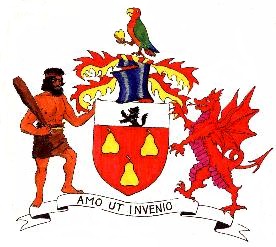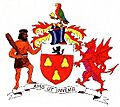John Perrot facts for kids
Quick facts for kids Sir John Perrot |
|
|---|---|
 |
|
| Painting by George Powle | |
| Spouse(s) | Anne Cheyne Jane Prust |
| Issue | |
| Sir Thomas Perrot Sir James Perrot |
|
| Father | Thomas Perrot |
| Mother | Mary Berkeley |
| Born | 7×11 November 1528 |
| Died | 3 November 1592 Tower of London |
Sir John Perrot (born 7 November 1528 – died 3 November 1592) was a powerful figure in England and Ireland during the time of Queen Elizabeth I of England. He worked as her Lord Deputy in Ireland. This was during a period when England was trying to gain more control over Ireland.
For a long time, some people thought he might have been a secret son of Henry VIII. However, modern historians have looked at the evidence and do not believe this is true.
Sir John Perrot was known for being a strong and sometimes quick-tempered person. He inherited a lot of wealth and power in Wales. He also became very close to the English royal court. One of his sons described him as "very cholericke," meaning he got angry easily and didn't like being challenged.
Contents
Early Life and Royal Connections
Perrot was born in November 1528, likely at Haroldston Manor in Pembrokeshire, Wales. His parents were Thomas Perrot and Mary Berkeley. He had two sisters, Jane and Elizabeth.
Because Sir John Perrot looked a bit like Henry VIII and had a similar strong personality, many people thought he was the King's secret son. However, this idea is not supported by facts. For example, Mary Berkeley already had two children before John, and there is no record of her being with the King at the right time.
Perrot began his career by joining the household of William Paulet, 1st Marquess of Winchester. This helped him meet King Henry VIII. After Henry VIII died in 1547, Perrot was knighted at the crowning of the new king, Edward VI.
In 1551, Perrot became the High Sheriff of Pembrokeshire. He also visited France as part of a group trying to arrange a marriage between Edward VI and the French king's daughter. The French King Henry II was so impressed by Perrot's skills as a knight that he wanted him to stay in France. Perrot refused, but the French Crown paid off his debts when he returned to England.
During the reign of Queen Mary I, Perrot was briefly put in prison. He was accused of helping people who were against the Queen's religious beliefs. After he was released, he fought for England in France at the capture of Saint-Quentin.
Perrot inherited Carew Castle and its lands. When Queen Elizabeth I became queen, he was put in charge of defending the coast of South Wales. He also served as a member of Parliament for several areas, including Pembrokeshire and Haverfordwest.
Serving in Ireland: Munster
In 1570, Sir John Perrot was asked to take on a new role as Lord President of Munster. Munster was a province in Ireland that was experiencing a major uprising called the Desmond Rebellions. He arrived in Ireland in 1571 and began a tough campaign to bring peace to the area.
The main rebel leader, Fitzmaurice, was hard to catch. Perrot even challenged him to a one-on-one fight. Fitzmaurice refused, saying that if he killed Perrot, the Queen would just send another leader. But if Perrot killed him, there would be no one to lead the rebels.
Perrot's challenge showed his daring nature. He was once ambushed by rebels who greatly outnumbered his forces. Luckily, he was saved when the rebels thought a small group of his cavalry was a much larger army. By 1572, Perrot had successfully ended the rebellion.
During his time as President, Perrot ordered the hanging of over 800 rebels. After the rebellion, he disagreed with the Crown's decision to put the Earl of Desmond back in charge of Munster. Perrot asked to be called back to England. In July 1573, he left Ireland without permission. He was allowed to resign his position.
Life in Wales and Challenges
After leaving Ireland, Perrot returned to Carew in Wales. He wanted to live a quiet life and get out of debt. He was given new roles, including vice-Admiral of the Welsh seas. He also served as Mayor of Haverfordwest from 1575 to 1577. He improved his castles and lands, turning some into grand homes.
In 1578, Perrot was accused of being too harsh and even dealing with pirates. However, the Queen still trusted him. He was put in charge of fighting piracy in Pembrokeshire. In 1579, he chased a pirate ship all the way to the coast of Belgium and captured its leader.
Later, Perrot's son Thomas married Dorothy Devereux. She was the stepdaughter of a very important royal favorite, Robert Dudley, 1st Earl of Leicester. The Queen was very angry because Perrot had not asked for her permission for the marriage. She suspected a plot between Perrot and Leicester's wife, whom she disliked. This marriage actually caused problems for Perrot instead of helping him.
Lord Deputy of Ireland: A New Challenge
In 1584, Perrot was appointed Lord Deputy of Ireland again. His main job was to start the "plantation" of Munster. This was a plan to take land from defeated Irish rebels and give it to English farmers and workers. The goal was to build new towns and grow crops.
Before he could start in the south, Perrot heard about raids in northern Ireland by Scottish clans. He led the Royal Irish Army north to stop them. The Scottish leader, Sorley Boy, escaped to Scotland but later returned with more fighters. Queen Elizabeth was angry about the cost of this campaign. However, by 1586, Perrot had made a deal with Sorley Boy that benefited both sides.
Around this time, Perrot also approved the capture of Hugh Roe O'Donnell. Hugh Roe was an important Irish leader who was tricked onto a merchant ship and imprisoned in Dublin Castle. This gave the English Crown some power over the Irish clans in County Donegal. Perrot's actions in the north also led to the submission of Hugh Maguire, another Irish lord.
The Munster plantation started slowly because of lawsuits from Irish landowners. However, Perrot had success in the west in 1585. He created a fair agreement with landowners in Connaught. This deal gave the Queen certain rents in exchange for settling land ownership and tenant rights.
In the same year, a parliament was held in Dublin. Many hoped that Irish lords would attend. The meetings were disappointing. Although a law was passed to take the rebel Earl of Desmond's lands, other important laws faced difficulties. Perrot became very frustrated with the political groups in parliament. He asked to be recalled to England in 1587.
Perrot often criticized other government officials, which made him many enemies. He had a long argument with the Archbishop of Dublin over money from St. Patrick's Cathedral, Dublin. He also caused problems with other officials. In January 1588, Queen Elizabeth finally agreed to his request to return to England.
Downfall and Death
When Perrot returned to England, he was elected as a Member of Parliament for Haverfordwest. He was also appointed to the Privy Council, a group of royal advisors. He continued to be interested in Irish affairs.
However, his enemies were working against him. After the defeat of the Spanish Armada, he was accused of treason. This was based on claims made by a former priest in Ireland. The priest said he had letters from Perrot to the King of Spain, promising to give England, Wales, and Ireland to Spain.
An investigation began in Dublin. More accusations came out, including claims that Perrot had spoken harshly about Queen Elizabeth. He was also accused of knowing about a rebellion in 1589 before it happened.
Perrot was sent to the Tower of London. In 1592, he was put on trial for treason. The letters and evidence about the rebellion were used against him. The most damaging evidence was about his disrespectful comments about Queen Elizabeth. Perrot insisted he was loyal. He famously cried out, "You win men's lives away with words" to the lawyers. But the jury found him guilty.
His sentencing was delayed for several months, possibly because the Queen considered pardoning him. However, Sir John Perrot died in the Tower of London in September 1592. It is believed he might have been poisoned.
After Perrot's imprisonment, some of his supporters in Ireland were replaced by English officials. These new officials were very strict and wanted to use force against the Irish clans. This led to more land being taken from Irish chiefs, which helped start the Nine Years War (1595–1603).
Family Life
Sir John Perrot was married twice. His first wife was Anne Cheyne. They had one son, Sir Thomas Perrot.
After Anne died, Perrot remained unmarried for ten years. In 1563 or 1564, he married Jane Prust. She was a widow with children from her first marriage. With Jane, Perrot had one son, William, and two daughters, Anne and Lettice.
- William Perrot (died 1587)
- Anne Perrott, who married Sir John Philipps, 1st Baronet
- Lettice Perrott, who married three times. Her third husband was Arthur Chichester, who also became Lord Deputy of Ireland.
When Perrot became Lord Deputy of Ireland, he made arrangements for his estates to go to his sons and their male descendants. This was likely a way to protect his family's wealth because his job in Ireland was risky.
Perrot also had at least four children born outside of his marriages. These included Sir James Perrot, John Perrot, and Elizabeth Perrot. Sir James Perrot later wrote a book about his father's life.
Images for kids




